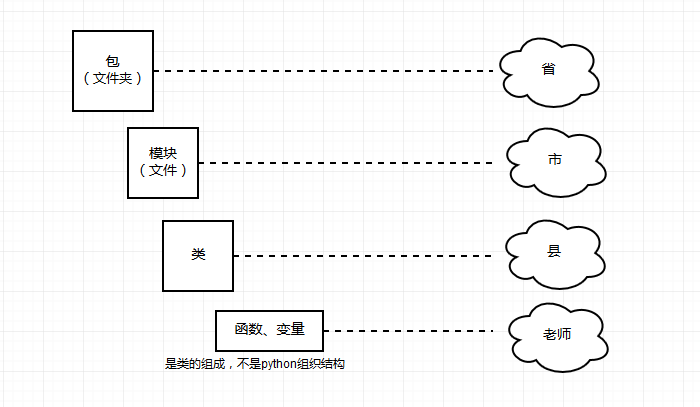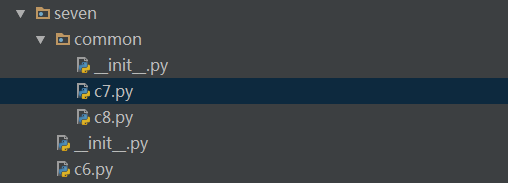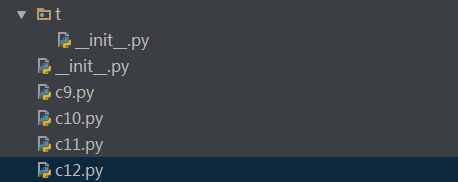七、包、模块、函数与变量作用域
一、while循环
1、关键点
1)条件不能是常量
2)代码块中必须有改变条件的语句
3)可结合else使用
4)适用场景:撸啊撸打怪,不知道目标有多远,直到达到目标。递归中常使用while循环
1 # coding=utf-8 2 3 # #条件为常量,无限死循环 4 # CONDITION=True 5 # while CONDITION: 6 # print('I am while') 7 8 9 # #初始条件不满足,不执行代码块 10 # counter=0 11 # while counter: 12 # counter+=1 13 # print(counter) 14 15 # counter=1 16 # while counter<=10: 17 # # counter+=1 18 # print(counter) 19 # counter+=1 20 21 # 与else结合使用 22 counter = 1 23 while counter <= 10: 24 counter += 1 25 print(counter) 26 27 else: 28 print('EOF')
二、for与for-else循环
1、关键点
1)适用场景:主要用来遍历(循环)序列、集合或者字典
2)可嵌套使用
3)现在一行打印使用print(x,end=' ')
4)可与else结合使用
5)遍历部分元素,可使用if
6)易错:break的使用
1 # coding=utf-8 2 3 # # 基本用法 4 # a = ['apple', 'orange', 'banana', 'grape'] 5 # for i in a: 6 # print(i) 7 8 9 # # # 嵌套使用 10 # s = [['a', 'b', 'c'], (1, 2, 3)] 11 # for x in s: 12 # for y in x: 13 # print(y) 14 # 15 # 16 # #一行打印end=' ' 17 # a = ['apple', 'orange', 'banana', 'grape'] 18 # for i in a: 19 # print(i,end=' ') 20 21 22 # #与else结合使用 23 # a = ['apple', 'orange', 'banana', 'grape'] 24 # for i in a: 25 # print(i) 26 # else: 27 # #当列表中所有元素遍历完成后执行else代码 28 # print('fruit is gone') 29 30 # 31 # # 结合if,遍历部分元素 32 # a = [1, 2, 3, 4] 33 # for x in a: 34 # if x == 2: 35 # break#中止循环 36 # print(x) 37 # 38 # print('--------------------') 39 # 40 # a1 = [1, 2, 3, 4] 41 # for x in a1: 42 # if x == 2: 43 # continue#跳过当前循环 44 # print(x) 45 46 47 # #易错,break的使用 48 # a=[1,2,3] 49 # for x in a: 50 # if x == 2: 51 # break 52 # print(x) 53 # else: 54 # print('EOF')#不会打印EOF 55 56 a=[['a', 'b', 'c'], (1, 2, 3)] 57 for x in a: 58 for y in x: 59 if y=='b': 60 break 61 print(y) 62 else: 63 print('gone')#gone会打印,break的作用域仅限于内层循环
三、for与range
1、关键点
1)range可按我们知道的规则生成序列
2)for循环与range结合,可实现按次数遍历
3)range与切片
1 # coding=utf-8 2 3 # for x in range(0,10):#包含0不包含10 4 # print(x) 5 6 7 # for x in range(0,10,2):#第三个参数2指定步长 8 # # print(x) 9 # print(x,end='|')#等差数列 10 11 12 # for x in range(10,0,-2):#改变方向 13 # print(x,end='|')#递减等差数列 14 15 # range和切片 16 # 打印a中相间隔的元素 17 a = [1, 2, 3, 4, 5, 6, 7, 8] 18 # 方法一:for循环 19 for i in range(0, len(a), 2): 20 print(a[i], end='|') 21 22 # 方法二:切片 23 b=a[0:len(a):2] 24 print(b)
四、python项目的组织结构

五、包与模块的命名
1、命名
包的名字:文件夹的名字
模块的名字:文件名
包.模块
区别:不同包下相同名字的模块,命名空间不同
2、关系
3、包的构成
文件夹+__init__.py=包
__init__模块的名字就是包名,而不是包名.__init__
六、多个模块间相互调用
好的结构是,提取公共代码在一个模块中,由其他模块调用。
引入方式:import 模块
1、python是解释型语言,使用前需要先定义
2、需要先引入模块,再使用模块中的方法、变量等
3、同级模块间调用,直接import 模块名;不同级模块调用,import 包.模块;多层调用,import 包.子包.模块,可使用别名as 简化调用
4、import后只能跟模块名,不能跟模块中的类、变量
七、from...import...导入
1、基本用法from 包/模块 import 模块/变量、类、方法
2、导入多个:from module import a,b,c,d
3、导入所有:from module import *
4、__all__内置属性控制*的范围
在c4.py中如下定义
1 __all__=['a','b'] 2 3 a = 1 4 b = 2 5 c = 3
c6.py调用c时,就会报错
from c4 import * print(a, b, c)
"C:\Program Files\Python36\python3.exe" E:/pyClass/seven/c6.py Traceback (most recent call last): File "E:/pyClass/seven/c6.py", line 3, in <module> print(a, b, c) NameError: name 'c' is not defined
九、__init__.py的用法
1、如何一次导入多个模块
from moudle import a,b,c,d....
1)代码换行
python一行最多允许80个字符
方法一:\
from c4 import a,b,\
c
方法二:()
from c4 import (a,b,
c)
2、__init__.py文件的作用
当包或模块被导入时,系统会自动先执行包下的__init__文件。

common的__init__文件中输入以下内容:
print("this is __init__.py")
c6.py导入c7文件
from common import c7
执行c6.py
"C:\Program Files\Python36\python3.exe" E:/pyClass/seven/c6.py this is __init__.py Process finished with exit code 0
3、在__init__文件中使用__all__内置变量

c7.py中代码如下:
1 __all__ = ['a', 'c'] 2 3 a = 2 4 c = 3 5 d = 4
c8.py中代码如下:
1 e = 2 2 f = 3 3 g = 4
__init__.py中代码如下
__all__=['c7']
c6.py中代码:
1 from common import * 2 3 print(c7.a) 4 print(c7.c) 5 print(c7.d) 6 print(c8.e)
运行结果
"C:\Program Files\Python36\python3.exe" E:/pyClass/seven/c6.py Traceback (most recent call last): 2 File "E:/pyClass/seven/c6.py", line 4, in <module> print(c8.e) NameError: name 'c8' is not defined
4、__init__可完成批量导入
例如:c9.py中需要导入多个类库
import sys
import datetime
import io
print(sys.path)
在c10.py、c11.py、c12.py、c13.py、c14.py...都需要导入以上类库,那么可以将以上类库放在t包的__init__.py文件中,其他文件导入t即可

t的init文件输入以下内容
import sys
import datetime
import io
其他文件,导入t即可
import t
print(t.sys.path)
十、包与模块的几个常见错误
1、包和模块是不会被重复导入的
2、避免循环导入


3、python中导入某个模块时,会执行该模块内的代码
4、入口文件的概念




 浙公网安备 33010602011771号
浙公网安备 33010602011771号